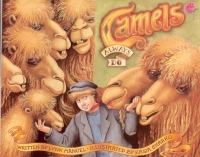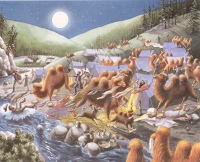| ________________
CM . . .
. Volume X Number 16 . . . . April 8, 2004

 |
Camels Always Do.
Lynne Manuel. Illustrated by Kasia Charko.
Victoria, BC: Orca, 2004.
32 pp., cloth, $16.95.
ISBN 1-55143-284-6.
Subject Headings:
Camels-Juvenile fiction.
Problem solving-Juvenile fiction.
Kindergarten-grade 3 / Ages 5-8.
Review by Harriet Zaidman.
***1/2 /4
Reviewed from f&g's. |

excerpt:
Cameron worked hard helping his father. While he worked, he talked about camels. He talked about camels with one hump. He talked about camels with two humps. He talked about camels in the morning. And he talked about camels at night. "Do camels always fill your thoughts?" his father asked him. Cameron nodded. "Camels always do," he said.
 An obscure piece of Canadian history is brought to life for young children in this pattern story about the Cariboo Gold Rush of 1862-1865, a time when tens of thousands trekked into the interior of British Columbia in search of the mineral that has captivated humankind for millennia. The fictional hero is Cameron, a young boy who has survived the trails to arrive at the goldfields. He prefers reading about camels to panning for gold, but father's dream is to find the gold so they can travel to those faraway places. Cameron is witness to one of the more enterprising events of the Gold Rush. Frank Laumeister, a Bavarian businessman, imported camels to carry supplies to the gold fields, reasoning that they could go for long periods of time without food and water and that their long legs would get them through snowdrifts in wintertime. He misnamed his Bacterian pack The Dromedary Express; his
expectations were misinformed as well.
Cameron's father, wisely realizing that he might make a better living as a camel driver than a gold
prospector, signs up with Laumeister. Soon Cameron and his father are on the trail, but problems
arise. Camels' feet are suited to soft, sandy deserts, and their hooves are torn by the rocky
surfaces of the canyons and mountain passes. Booties made from rawhide and canvas form only a
stopgap measure. Camels also stink, and no amount of rosewater scrubbing in the creek can make
them smell like roses. Pack mules on the trail are afraid of them, and the camels' naturally nasty
personalities cause chaos in camp.
Our young camel expert does the right thing and frees the camels, keeping his favourite, Barnum,
as a pet who doubles as an ox to pull the plow when Cameron and his father settle down to make
a living as farmers in the Cariboo. Their exotic pet fulfills their yearning for faraway places.
The narrative is rhythmic and upbeat, with Cameron answering, "Camels always do" whenever the
adults make yet another discovery about the animals' unsuitability to their task. The illustrations
by Kasia Charko show the mass of humanity that crowded into tent camps in search of their
fortunes and the seemingly impossible conditions of the Rush. She does a credible job of depicting
history accurately, but interestingly, for young children. Camels Always Do will be a welcome addition to school as well as classroom libraries. It can
serve as a catalyst for research into a unique period in the history of Western Canada that
propelled the rate of European settlement forward by decades and created conditions for Canada
to lay claim to the territory. An obscure piece of Canadian history is brought to life for young children in this pattern story about the Cariboo Gold Rush of 1862-1865, a time when tens of thousands trekked into the interior of British Columbia in search of the mineral that has captivated humankind for millennia. The fictional hero is Cameron, a young boy who has survived the trails to arrive at the goldfields. He prefers reading about camels to panning for gold, but father's dream is to find the gold so they can travel to those faraway places. Cameron is witness to one of the more enterprising events of the Gold Rush. Frank Laumeister, a Bavarian businessman, imported camels to carry supplies to the gold fields, reasoning that they could go for long periods of time without food and water and that their long legs would get them through snowdrifts in wintertime. He misnamed his Bacterian pack The Dromedary Express; his
expectations were misinformed as well.
Cameron's father, wisely realizing that he might make a better living as a camel driver than a gold
prospector, signs up with Laumeister. Soon Cameron and his father are on the trail, but problems
arise. Camels' feet are suited to soft, sandy deserts, and their hooves are torn by the rocky
surfaces of the canyons and mountain passes. Booties made from rawhide and canvas form only a
stopgap measure. Camels also stink, and no amount of rosewater scrubbing in the creek can make
them smell like roses. Pack mules on the trail are afraid of them, and the camels' naturally nasty
personalities cause chaos in camp.
Our young camel expert does the right thing and frees the camels, keeping his favourite, Barnum,
as a pet who doubles as an ox to pull the plow when Cameron and his father settle down to make
a living as farmers in the Cariboo. Their exotic pet fulfills their yearning for faraway places.
The narrative is rhythmic and upbeat, with Cameron answering, "Camels always do" whenever the
adults make yet another discovery about the animals' unsuitability to their task. The illustrations
by Kasia Charko show the mass of humanity that crowded into tent camps in search of their
fortunes and the seemingly impossible conditions of the Rush. She does a credible job of depicting
history accurately, but interestingly, for young children. Camels Always Do will be a welcome addition to school as well as classroom libraries. It can
serve as a catalyst for research into a unique period in the history of Western Canada that
propelled the rate of European settlement forward by decades and created conditions for Canada
to lay claim to the territory.
Highly Recommended.
Harriet Zaidman is a teacher-librarian in Winnipeg, MB.

To comment on this
title or this review, send mail to cm@umanitoba.ca.
Copyright © the Manitoba Library Association. Reproduction for personal
use is permitted only if this copyright notice is maintained. Any
other reproduction is prohibited without permission.
NEXT REVIEW |TABLE OF CONTENTS FOR THIS ISSUE
- April 8, 2004.
AUTHORS
| TITLES | MEDIA REVIEWS
| PROFILES
| BACK ISSUES
| SEARCH | CMARCHIVE
| HOME
|

 An obscure piece of Canadian history is brought to life for young children in this pattern story about the Cariboo Gold Rush of 1862-1865, a time when tens of thousands trekked into the interior of British Columbia in search of the mineral that has captivated humankind for millennia. The fictional hero is Cameron, a young boy who has survived the trails to arrive at the goldfields. He prefers reading about camels to panning for gold, but father's dream is to find the gold so they can travel to those faraway places. Cameron is witness to one of the more enterprising events of the Gold Rush. Frank Laumeister, a Bavarian businessman, imported camels to carry supplies to the gold fields, reasoning that they could go for long periods of time without food and water and that their long legs would get them through snowdrifts in wintertime. He misnamed his Bacterian pack The Dromedary Express; his
expectations were misinformed as well.
Cameron's father, wisely realizing that he might make a better living as a camel driver than a gold
prospector, signs up with Laumeister. Soon Cameron and his father are on the trail, but problems
arise. Camels' feet are suited to soft, sandy deserts, and their hooves are torn by the rocky
surfaces of the canyons and mountain passes. Booties made from rawhide and canvas form only a
stopgap measure. Camels also stink, and no amount of rosewater scrubbing in the creek can make
them smell like roses. Pack mules on the trail are afraid of them, and the camels' naturally nasty
personalities cause chaos in camp.
Our young camel expert does the right thing and frees the camels, keeping his favourite, Barnum,
as a pet who doubles as an ox to pull the plow when Cameron and his father settle down to make
a living as farmers in the Cariboo. Their exotic pet fulfills their yearning for faraway places.
The narrative is rhythmic and upbeat, with Cameron answering, "Camels always do" whenever the
adults make yet another discovery about the animals' unsuitability to their task. The illustrations
by Kasia Charko show the mass of humanity that crowded into tent camps in search of their
fortunes and the seemingly impossible conditions of the Rush. She does a credible job of depicting
history accurately, but interestingly, for young children. Camels Always Do will be a welcome addition to school as well as classroom libraries. It can
serve as a catalyst for research into a unique period in the history of Western Canada that
propelled the rate of European settlement forward by decades and created conditions for Canada
to lay claim to the territory.
An obscure piece of Canadian history is brought to life for young children in this pattern story about the Cariboo Gold Rush of 1862-1865, a time when tens of thousands trekked into the interior of British Columbia in search of the mineral that has captivated humankind for millennia. The fictional hero is Cameron, a young boy who has survived the trails to arrive at the goldfields. He prefers reading about camels to panning for gold, but father's dream is to find the gold so they can travel to those faraway places. Cameron is witness to one of the more enterprising events of the Gold Rush. Frank Laumeister, a Bavarian businessman, imported camels to carry supplies to the gold fields, reasoning that they could go for long periods of time without food and water and that their long legs would get them through snowdrifts in wintertime. He misnamed his Bacterian pack The Dromedary Express; his
expectations were misinformed as well.
Cameron's father, wisely realizing that he might make a better living as a camel driver than a gold
prospector, signs up with Laumeister. Soon Cameron and his father are on the trail, but problems
arise. Camels' feet are suited to soft, sandy deserts, and their hooves are torn by the rocky
surfaces of the canyons and mountain passes. Booties made from rawhide and canvas form only a
stopgap measure. Camels also stink, and no amount of rosewater scrubbing in the creek can make
them smell like roses. Pack mules on the trail are afraid of them, and the camels' naturally nasty
personalities cause chaos in camp.
Our young camel expert does the right thing and frees the camels, keeping his favourite, Barnum,
as a pet who doubles as an ox to pull the plow when Cameron and his father settle down to make
a living as farmers in the Cariboo. Their exotic pet fulfills their yearning for faraway places.
The narrative is rhythmic and upbeat, with Cameron answering, "Camels always do" whenever the
adults make yet another discovery about the animals' unsuitability to their task. The illustrations
by Kasia Charko show the mass of humanity that crowded into tent camps in search of their
fortunes and the seemingly impossible conditions of the Rush. She does a credible job of depicting
history accurately, but interestingly, for young children. Camels Always Do will be a welcome addition to school as well as classroom libraries. It can
serve as a catalyst for research into a unique period in the history of Western Canada that
propelled the rate of European settlement forward by decades and created conditions for Canada
to lay claim to the territory.